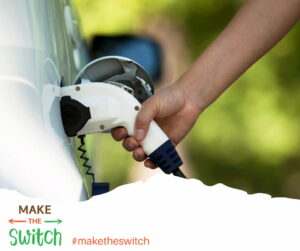Let's Action the strategy!
WE WANT TO HEAR FROM YOU!
ACTION ON CLIMATE
Our climate is changing. The world has already warmed by 1°C above pre-industrial levels due to human activities. Canada is warming at a faster rate with overland temperatures increasing an average of 1.7°C between 1948 and 2016 and about 2.3°C for northern Canada with the majority being due to human activities. Burlington is not immune to the impacts of climate change and has already experienced many examples of what is predicted to become more common.
Burlington Council approved a community-based Climate Action Plan in 2020 which identifies seven program areas of focus to reduce greenhouse gas emissions and achieve the community net carbon neutral target by 2050. Implementing measures and policies to support electric mobility options in Burlington is one of the key areas to help reduce emissions from the transportation sector. To that end, BurlingtonGreen was pleased to collaborate with the City of Burlington to develop a community based E-Mobility Strategy for Burlington.

It is recognized that our transportation system, which has prioritized the use of single occupancy vehicles over other modes, will need to be restructured to provide residents with more transportation options that prioritize active, public and shared transportation modes. There is the recognition that the movement from ICE vehicles towards EVs is also a critical component of the actions needed to reduce emissions from our transportation system. Focusing on electric mobility is a recognition of the car ownership culture in Burlington and, therefore, to be successful in reducing emissions and achieving the carbon reduction targets, electrification of the transportation sector needs to be a priority. However, shifting the modal split and supporting sustainable transportation options also remains a priority in the community.
WHY GO ELECTRIC?
 Greatly lower your eco-footprint; drive with a clear conscience: Burlington has higher than average car ownership and over 40% of Burlington’s community GHG emissions are from the transportation sector. By switching to an electric vehicle, you can make a very large reduction in your environmental footprint. The electricity used to charge the vehicle in Ontario is from relatively clean sources now that Ontario has shut down its coal-fired power plants.
Greatly lower your eco-footprint; drive with a clear conscience: Burlington has higher than average car ownership and over 40% of Burlington’s community GHG emissions are from the transportation sector. By switching to an electric vehicle, you can make a very large reduction in your environmental footprint. The electricity used to charge the vehicle in Ontario is from relatively clean sources now that Ontario has shut down its coal-fired power plants.
Low energy costs: Avoid paying for gasoline. Your energy costs will be on your electricity bill, but you can charge in the evening at off-peak times or for FREE at many public chargers. As carbon taxes are levied on gasoline, you should be ahead in the long run. If you want the reassurance of having gasoline back-up, you can purchase a Plug-in Hybrid Electric Vehicle (PHEV) that runs mostly on electric, but has a gas tank back-up for extra range, just in case.
Low maintenance: EVs do not have internal combustion engines that require maintenance to the numerous moving parts – electric motors are much simpler systems. No more oil changes. No muffler systems to replace. No starter motors to replace (which can suddenly die in gas-powered cars and leave you calling for a tow truck). Usually, no radiators, water pumps, or coolant hoses and fluids to worry about (which can suddenly overheat or spring a leak and leave you stranded on the side of the road). Usually no complex transmission systems. EVs and hybrids use regenerative braking systems to recover energy when stopping and using it to recharge the battery; this also has the added benefit of often greatly prolonging brake life since the brake pads don’t have to work as hard, which can further reduce maintenance costs on your vehicle.
Often cheaper: Take advantage of government incentives offered to purchase EVs. With incentives offered and lower operating costs mentioned above, the overall life-cycle cost of an EV is now often cheaper than that of a traditional gasoline car.
Less highway traffic: slide into the HOV/HOT lanes to beat traffic on the 403/QEW. EVs have their privileges! Note: special green license plate required (learn more here). Also, fingers crossed for more “EV/hybrid only” premium parking spaces popping up at workplaces, stores and parking lots in the future.

more resources
- Check out the ChargeHub map for electric charging station locations in Burlington.
- Visit 2030 EV Action Plan to learn more about the roadmap to achieve 100% electric passenger vehicle sales by 2030. Read the plan’s 6 pillars to support the transition to electric mobility.
- For more information on EVs, please visit PlugNDrive and check out their EV Discovery Centre in North York, Ontario.
- Eight common questions about electric vehicles
- Check out EV Society’s new Knowledge Centre for EV information, ownership 101, tips and more!
- Accelerate, a new 20-member consortium of auto manufacturers, industry associations, think tanks, and mining organizations launched in September 2021. Its goal is to organize and align Canada’s zero-emissions vehicle supply chain to ensure its growth and success.
- Follow Electric Autonomy Canada for the latest EV news and trends.
- Learn how the Atmospheric Fund (TAF) is finding ways to bring down carbon in the transportation sector across the GTHA.
- Visit the Electric Vehicle Society and tune in to their Canada Talks Electric Cars webinar series
- Solutions for Multi-Residential Electric Vehicle Charging: Resources
- Check out these EPA EV Myths
AVAILABLE INCENTIVES
- Visit the Government of Canada website to discover current incentives.
- Used Electric Vehicle Incentive: Ontario drivers qualify for $1,000 toward the purchase of a used fully electric car. This incentive does not include plug-in hybrids. The car must be registered and insured in Ontario, be for personal-use and have a re-sale sticker price below $50,000 CDN before taxes. Visit PlugNDrive for more info.
Be sure to explore Make the Switch, Live Green or Event Greening for more helpful resources to support your sustainability journey.
Showcase your support for a cleaner, greener Burlington!
Contact us today to learn more about our many rewarding sponsorship opportunities.




